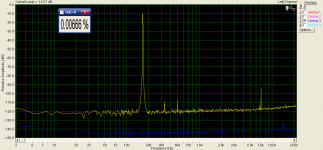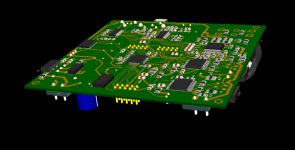Back when I bought my MiniDSP I thought it was just a matter of months before we had several simple 100 watt TASXXX digital input DIY amplifiers. But where a they?
TI have evap boards, but they are quite expensive.
TAS5612LA | Mid/High-Power Amplifier | Speaker Amplifier and Modulator | Description & parametrics
Do other manufactures have similar aval boards. I just need one digital input, no DSP or other stuff. I have that already.
TI have evap boards, but they are quite expensive.
TAS5612LA | Mid/High-Power Amplifier | Speaker Amplifier and Modulator | Description & parametrics
Do other manufactures have similar aval boards. I just need one digital input, no DSP or other stuff. I have that already.
what about samples?
I have some similar ones, they might be tas5261.. are you looking for IC or eval boards?
I have some similar ones, they might be tas5261.. are you looking for IC or eval boards?
I'm looking for a finished PCB just like the countless analogue types that are all over aliexpress and ebay.
well, i want hear direct-digtal...but i found not much about that, especially about > how does it sound ? < -- but seems, nobody knows...or want to tell 😕
so i decided, to try myself...
and made a test: i program pcm -> pwm converter, to see, how good this could be;
was some work on a ARM cpu and with standard test, sine wave, looks not bad;
see att. pic
for this, i want a simple setup first - and looked for "ready" amps, but nothing cheap to find;
next is, to build an amp ...i decided for a test the STAxx chips from STM;
at the moment first layout is almost finished, 100x100mm board...see pic.
it has:
- the digital FFX amp , 2 x20W
- supply reg.
- system controller (ARM F0) for volume (filter etc.), IR-remote , LCD display etc.
- spdif opt + cinch in
- usb in
first i will try without biquad filters and much processing, just volume control...
so i decided, to try myself...
and made a test: i program pcm -> pwm converter, to see, how good this could be;
was some work on a ARM cpu and with standard test, sine wave, looks not bad;
see att. pic
for this, i want a simple setup first - and looked for "ready" amps, but nothing cheap to find;
next is, to build an amp ...i decided for a test the STAxx chips from STM;
at the moment first layout is almost finished, 100x100mm board...see pic.
it has:
- the digital FFX amp , 2 x20W
- supply reg.
- system controller (ARM F0) for volume (filter etc.), IR-remote , LCD display etc.
- spdif opt + cinch in
- usb in
first i will try without biquad filters and much processing, just volume control...
Attachments
Looking good. I don't have these skills, so have to rely on ready made boards.
I have heard some different equibit based solutions. Both Lyngdorf, MiniDSP and Panasonic. They all have one thing in common, and that is transparancy. It's simply easier to here details in complex recordings.
I have heard some different equibit based solutions. Both Lyngdorf, MiniDSP and Panasonic. They all have one thing in common, and that is transparancy. It's simply easier to here details in complex recordings.
not much guys 🙂
This is the one used in panasonic sa-xr55
TAS5182 | Mid/High-Power Amplifier | Speaker Amplifier and Modulator | Description & parametrics
What is the best sounding chip available today? The above is quite old, but open loop, where the new ones are closed loop.
This is the one used in panasonic sa-xr55
TAS5182 | Mid/High-Power Amplifier | Speaker Amplifier and Modulator | Description & parametrics
What is the best sounding chip available today? The above is quite old, but open loop, where the new ones are closed loop.
oh, digital-closed-loop ? which chip does this ?
i found the chips from Ti , STM and Apogee - afaik they all are straight open loop ...
btw
seems, Apogee developed this at first, see
Apogee Technology, Inc.
i found the chips from Ti , STM and Apogee - afaik they all are straight open loop ...
btw
seems, Apogee developed this at first, see
Apogee Technology, Inc.
Yes, good idea. Some have manager to go directly via I2S, and som modify the PSU and report close to TACT fidelity. I gave 100 $ for mine.
Right now, I use it with analogue input. It's ok but nothing special. The magic happens with digital input. It's very detailed and easy to decifer the music. Some Will call it cold and analytical, but for me I relax more, because I don't have to concentrate to hear details in the music. In dual amp mode, there is plenty of headroom, and rock solid low end. Just don't push it, then it will sound very harsh.
***Panasonic. They all have one thing in common, and that is transparancy. It's simply easier to here details in complex recordings.
That's just because they don't have flat frequency response into real loads. The XR55 has the fidelity of an SET but with more bass.
I don't think that is true.
Think whatever you want. Facts are facts. And the fact of the matter is that in the midrange and treble the source impedance of the XR55 is basically equivalent to a SET amp, with the attendant FR errors in those bands when the amp is asked to drive a non-resistant load. The midbass and down is far superior to a SET or other antique tube amp.
Now, they're fine for active speakers, so long as the interaction of each driver and amp channel is measured for crossover design.
You have one. (Mine is long gone, for the reasons stated above.) Take measurements of a loudspeaker driven by it, and then swap out the amp for a known good solid state amp with low output impedance and flat FR. Or one of the known good Class D technologies, such as Icepower ASX2 or Hypex UcD/Ncore.
Think whatever you want. Facts are facts. And the fact of the matter is that in the midrange and treble the source impedance of the XR55 is basically equivalent to a SET amp, with the attendant FR errors in those bands when the amp is asked to drive a non-resistant load. The midbass and down is far superior to a SET or other antique tube amp.
Now, they're fine for active speakers, so long as the interaction of each driver and amp channel is measured for crossover design.
You have one. (Mine is long gone, for the reasons stated above.) Take measurements of a loudspeaker driven by it, and then swap out the amp for a known good solid state amp with low output impedance and flat FR. Or one of the known good Class D technologies, such as Icepower ASX2 or Hypex UcD/Ncore.
It's a sonic nature I have heard on every equibit amplifier I have heard (not only SA-XR55 but also SA-XR50 MiniAMP and Tact Millenium Mk III), that's why I don't think it's because of any frequency irregularities. I only use it in an active setup and I finetune freq and crossover with measurement mic. (I have a MiniDSP)
Pallas: Do you you recommend DAC + analogue input Class D over digital input Class D (just like Bruno Putzey)?
Pallas: Do you you recommend DAC + analogue input Class D over digital input Class D (just like Bruno Putzey)?
Digital *input* is one thing - it doesn't really matter if you have a separate DAC or a DAC built-in in the amp (apart from the fact that DACs tend to get obsolete quicker than amps), but analog class D vs. digital control/feedback class D is another matter altogether. Digital feedback is really, really tricky to get right.
It's not where the DAC is places I'm after. I know about that part.
It's the digital controlled class D vs analogue controlled class D I'm hunting.
In a Panasonic I would expect they know what they are doing! At least they share some of the same footprint as the "original" Tact Millenium.
Overall I don't think differences in well made amplifiers really matter (regardless of classes), but I do like what equibit amplifiers do when it comes to pin out details from the digital signal.
It's the digital controlled class D vs analogue controlled class D I'm hunting.
In a Panasonic I would expect they know what they are doing! At least they share some of the same footprint as the "original" Tact Millenium.
Overall I don't think differences in well made amplifiers really matter (regardless of classes), but I do like what equibit amplifiers do when it comes to pin out details from the digital signal.
- Status
- Not open for further replies.
- Home
- Amplifiers
- Class D
- digital controlled PWM amplifiers

